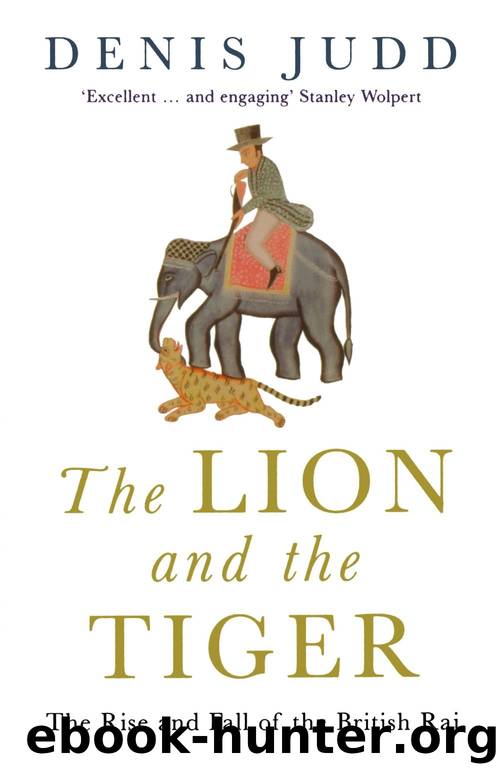The Lion and the Tiger: The Rise and Fall of the British Raj, 1600-1947 by Denis Judd

Author:Denis Judd [Judd, Denis]
Language: eng
Format: epub
Tags: Asia, General, Europe, Great Britain, World, Modern, History, India & South Asia
ISBN: 9780192805799
Google: hlf9u1asHTAC
Publisher: OUP Oxford
Published: 2005-03-23T23:00:00+00:00
The summer heat that has so badly affected âPagett M.P.â proved equally troublesome to those who upheld the Raj. âPrickly heatâ, for instance, was described as âa sort of rash which breaks out on you, and, as its name infers, is prickly in its nature. I can only compare it to lying in a state of nudity on a horse hair sofa, rather worn, and with the prickles of the horse hair very much exposed, and with other horse hair sofas above you, and all around, tucking you in. Sitting on thorns would be agreeable by comparison, the infliction in that case being local.â96
Despite Noel Cowardâs later lampoon of âMad Dogs and Englishmenâ, it was in practice best for Europeans to shelter from the sun between midday and two oâclock in the afternoon: âThe white sunlight lies upon the roads in so palpable a heat that it might be peeled off: the bare blinding walls, surcharged with heat, refuse to soak in any more. . . . In the dusty hollows of the roadside the pariah dogs lie sweltering in dry heat. Beneath the trees sit the crows, their beaks agape. The buffaloes are wallowing in the shrunken mud-holes, but not a human being is abroad of his own will.â97
When the weather became cooler, or in the evenings, it was possible to enjoy a promenade in a respectable part of town, to listen to the military music being played in the bandstand, to admire the red poinsettias (a tropical flower): âOne could go to friends for dinner, or perhaps to an official reception. When the rains came, the garden would sprout overnight, the roof might leak . . . and cockroaches and snakes invade the verandah.â
Despite the drenching monsoon rains, it was the Indian heat that was generally considered worse and more dangerous. In the hot season, those families who could afford it went to the hill stations, many of which became similar to holiday resorts. Here the air was crisp and cool, and diseases like cholera were kept at bay. The most famous hill station was Simla, where the Viceroy and his retinue came to escape from Calcuttaâs feverish heat. Simla, and other hill stations, soon acquired the reputation for a vigorous social life, romance, and adulterous liaisons.
Before all this could be experienced, however, the women and children had to travel from the plains to the hills. This is how it was proposed to transport a typical family consisting of a mother, three or four children, and a nurse or ayah:
Download
This site does not store any files on its server. We only index and link to content provided by other sites. Please contact the content providers to delete copyright contents if any and email us, we'll remove relevant links or contents immediately.
| Africa | Americas |
| Arctic & Antarctica | Asia |
| Australia & Oceania | Europe |
| Middle East | Russia |
| United States | World |
| Ancient Civilizations | Military |
| Historical Study & Educational Resources |
Magic and Divination in Early Islam by Emilie Savage-Smith;(1500)
Ambition and Desire: The Dangerous Life of Josephine Bonaparte by Kate Williams(1344)
Bohemians, Bootleggers, Flappers, and Swells: The Best of Early Vanity Fair by Bohemians Bootleggers Flappers & Swells- The Best of Early Vanity Fair (epub)(1343)
Papillon by Henry Charrière(1309)
Twelve Caesars by Mary Beard(1256)
Operation Vengeance: The Astonishing Aerial Ambush That Changed World War II by Dan Hampton(1134)
What Really Happened: The Death of Hitler by Robert J. Hutchinson(1128)
London in the Twentieth Century by Jerry White(1112)
Time of the Magicians by Wolfram Eilenberger(1087)
The Japanese by Christopher Harding(1086)
Twilight of the Gods by Ian W. Toll(1084)
Lenin: A Biography by Robert Service(1043)
The Devil You Know by Charles M. Blow(985)
A Social History of the Media by Peter Burke & Peter Burke(936)
Freemasons for Dummies by Hodapp Christopher;(922)
Napolean Hill Collection by Napoleon Hill(902)
Henry III by David Carpenter;(891)
The Churchill Complex by Ian Buruma(879)
The Rise and Triumph of the Modern Self by Unknown(877)
